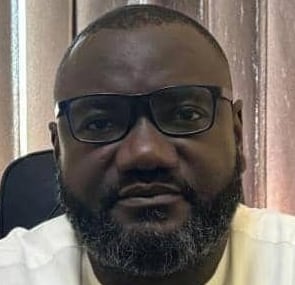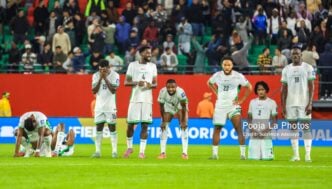NAF jet | File photo
The sky is where everything in life is determined. It jealously looks over the earth and its subjects. When you travel by air and peep out of the aircraft window, what do you see? You see your imagination. You reflect and develop a deep sense of judgement. And you want to win by all means. This is propelled by the height the aircraft attained. This played out in Operation Desert Storm during the Gulf War between the Allied Forces and Iraq. The war was won in the air with 20 days of constant aerial bombardment of Iraq and Iraqi-occupied territories in Kuwait. It validated the US “Air-Land Battle Doctrine,” which has played a crucial role in shaping U.S. military strategy.
The magician called NAF L-39ZA Albatros.
In 2016, the Nigerian Military launched Operation Deep Punch in Borno State in the heat of the Boko Haram insurgency. It was a counterinsurgency operation under Operation Lafiya Dole. It was targeted to drive out Boko Haram/ISWAP elements from their stronghold in Sambisa Forest. It was a combination of air strikes, ground offensives, intelligence-led raids, and clearance of identified insurgents’ tactical camps, such as “Camps Zero, 1, 2 and 3,” to rescue hostages and recover seized territories. At the time, Gwoza was the operational headquarters of the insurgents, and after they were dislodged, the Nigerian Army established the 26 Task Force Brigade in the town, hitherto famous for the police mobile force training school.
In 2017, Operation Deep Punch 2 was launched. It was intended to clear areas where dispersed insurgents hibernated. The military liberated all towns previously occupied by the insurgents. The Nigerian Air Force played a significant role in the success of both campaigns by providing tactical air support for the ground troops. The NAF L-39ZA Albatros was the “King of the Skies” in Operation Deep Punch 1 and 2. According to sources, the fighter jets performed magic during the operations with precise aerial bombardment and adequate air cover for the ground troops.
Advertisement
In my opinion, whoever it was that coordinated the Air Component under Operation Deep Punch 1 and 2 should be located, even if retired and brought to the table to share insights into the successes recorded in that operation. Secondly, the officer who commanded the ground troops should also be looked for. His insights would be valuable. The current Chief of Army Staff, Lt. Gen. Waidi Shaibu, was reportedly in the theatre of operations at the time. But one is not sure if he was a part of that operation. He was there as a Colonel, Brigadier General and Major General respectively. He suffered gunshot injuries on two occasions. He knows the geography and peculiarities of that part of the country.
The sky is an advantage.
This article only serves as a reminder that the success or otherwise of military operations depends largely on the synergy between air and land forces. The Air Force lays the foundation for success or otherwise. There is a stark reality. The moment the insurgents include air attacks as a part of their strategy, we might as well bid farewell to the existence of Nigeria. It is not impossible. This is why the Air Force must continue to carry out aerial bombardment of key infrastructures of the insurgents, such as their ammunition storage facilities, as well as identified entry and exit routes for their supplies. The last time I checked, the Air Force has in its arsenal 12 units of A-29 Super Tucano Fighter Jets which cost the country quite a fortune. The purchase is argued to be the largest in Sub-Saharan Africa. If indeed we have these fighter jets in our military arsenal, there is no better time to deploy them than now. There should be no limitations in its deployment.
Advertisement
The Law of Armed Conflict is unfavourable.
The Chief of Air Staff, Air Marshal Sunday Aneke, seems to be advocating for air dominance in the Boko Haram insurgency through his “fly smart, strike hard” operational philosophy. He has made very instructive points in recent times. For example, during an operational visit to the theatre of operations, the Air Chief highlighted that the “Air Force is expanding its Intelligence, Surveillance, and Reconnaissance (ISR) capabilities to improve targeting of Boko Haram and ISWAP terrorists, while minimizing collateral damage and ensuring civilian protection in the North East Region and other parts of the country.” This is instructive.
I have refrained from commenting on the provisions of the Law of Armed Conflict (LOAC) that regulate the conduct of participants during an armed conflict by the means and methods of warfare. In my opinion, there are complications in its implementation. The interpretation of these rules continues to be a challenge since the evolution of asymmetric warfare. I do not agree that LOAC provisions should be exercised in asymmetric wars. The reason is simple. The professional fighting forces are restricted, while the insurgents are not. This is a great disadvantage. It has been argued by scholars that the LOAC provisions of “Distinction, Proportionality and Necessity” are encumbrances that prolong wars.
Distinction requires that “civilians must be protected and attacks must be directed only at military targets.” In the case of the Boko Haram insurgency, you can’t distinguish between Boko Haram fighters and civilians easily. They speak the local language. They live among the locals. In such circumstances, “distinction” is always a herculean task. Proportionality mandates that “attacks must not cause excessive harm to civilians or damage to civilian objects.” This aspect is the most tedious. How do you define proportionality when the enemy is within sight? The ultimate aim in that situation is to take out the enemy with every arsenal possible. For example, when faced with an adversary and the only weapon you have is a Rocket Propelled Grenade (RPG). Would you remember that the LOAC restricts you from hitting the button? If you indeed remembered and restrained. God help you. Necessity stipulates that “actions must be required to achieve a specific military goal.” Have the insurgents not committed grievous crimes against the people and the state? What further justification does the military need to deal decisively with the insurgents?
Advertisement
The strike must be harder.
Given the precarious situation we have found ourselves in, the Air Force can only “fly smarter and strike harder.” It is important we continue to maximize our air advantage. The battle of the skies is a delicate one. It is another chapter in insurgency. Who would have thought that the insurgents would be as daring as they have become in recent times? Unfortunately, insurgencies don’t end. They revolve endlessly. The Revolutionary Armed Forces of Colombia (FARC) is one of the oldest and dangerous insurgent groups in the world. It was founded in 1966. It agreed to disarm in 2017 and transformed into a political party, “The Common Alternative Revolutionary Force.” But FARC-related violence still exists in Colombia.
The insurgency in the northeast is still going to be with us for a while. Once upon a time, it was “Jama’at Ahl al-Sunna li al-Da’wa wa al-Jihad” (Boko Haram); now, there is also the Islamic State West Africa Province. (ISWAP). Today, these groups are fighting for control of territories in the northeast. And their common enemy is the military. This is funny, but the reality is that the military is fighting a 2-in-1 war. It is time for decisive action. We need to get insights from the successes of Operation Desert Storm and Operation Deep Punch, 1 and 2. The lessons learnt should define the next Operation Deep Punch or another sobriquet to reflect realities of the time. If I were to suggest a name for a follow-up operation, it will revolve around “thunder” as a phenomenon. “Thunder” comes deep in our folklore. It connotes lethal devastation. Its name doesn’t sound friendly in most of our languages. For example, Akpabana in Igala dialect means “thunder.”
Ocheja, PhD, is a military historian and an alumnus of the Nigerian Defence Academy.
Advertisement
Views expressed by contributors are strictly personal and not of TheCable.




